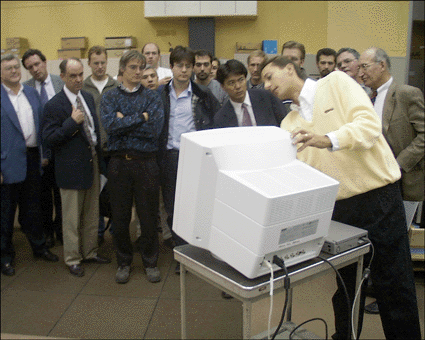Geneva, 11 October 1999. A demonstration Gigabyte System Network (GSN) was built during a workshop organised by CERN1, in collaboration with the High Performance Networking Forum (HNF). This was only the second time that GSN has been demonstrated in Europe, and it was the largest GSN to be built anywhere.
Geneva, 11 October 1999. A demonstration Gigabyte System Network (GSN) was built during a workshop organised by CERN1, in collaboration with the High Performance Networking Forum (HNF). This was only the second time that GSN has been demonstrated in Europe, and it was the largest GSN to be built anywhere.
GSN is a new type of network which allows data to be transferred between computers at speeds of up to 800 Mbytes/sec (800 000 000 characters per second). This makes it the fastest operational network standard today - eight times faster than any previous type of network. CERN engineers have helped to create the GSN standard, and in particular developed a bridge to connect GSN to the increasingly popular Gigabit Ethernet architecture, as a joint project with Genroco Inc.
The CERN network used a new network protocol called Scheduled Transfer (ST). ST allows data to be transferred from one system to another with minimal intervention from the host operating system. ST runs over conventional networks such as Gigabit Ethernet and HIPPI as well as over GSN, and allows computers direct access via these networks to storage devices such as disks and tapes with standard interfaces (SCSI or Fibre Channel). CERN's was the first demonstration of a Storage Area Network running over multiple networks.
The combination of GSN and ST supports high performance computing, networking and storage facilities as required to handle the massive data volumes generated by High Energy Physics accelerators such as the Large Hadron Collider (LHC) being built at CERN. Other potential uses include the mining of very large databases, graphics intensive computing such as in the cinema and video industries, and applications for Internet Service Providers that have to handle increasing quantities of data, generated for example by "TV on Demand" and "Web TV".
1. CERN, the European Laboratory for Particle Physics, has its headquarters in Geneva. At present, its Member States are Austria, Belgium, Bulgaria, the Czech Republic, Denmark, Finland, France, Germany, Greece, Hungary, Italy, Netherlands, Norway, Poland, Portugal, Slovakia, Spain, Sweden, Switzerland and the United Kingdom. Israel, Japan, the Russian Federation, the United States of America, Turkey, the European Commission and Unesco have observer status.
